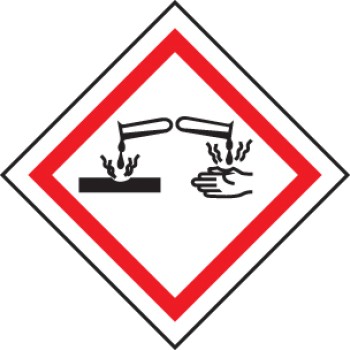Using GHS Labels for Corrosive Substances is essential for clearly identifying chemicals that can cause severe damage to skin, eyes, metals, and other materials. These labels warn workers, handlers, and emergency responders about the risks of chemical burns, tissue damage, and material corrosion, helping them take the necessary precautions during handling, storage, and transport.
One key reason to use GHS corrosive labels is to protect human health and safety. The labels alert individuals to use appropriate personal protective equipment (PPE) such as gloves, goggles, and protective clothing, and to follow strict safety procedures to avoid contact with these dangerous substances. This helps prevent serious injuries and accidents in the workplace.
GHS corrosive labels also promote safe storage and handling practices. Corrosive chemicals must be stored separately from incompatible materials and in containers resistant to corrosion. Proper labeling guides workers to handle these substances with care and maintain an organised, hazard-aware environment.
Finally, the use of GHS corrosive labels ensures compliance with international hazard communication standards. Adhering to the Globally Harmonised System (GHS) requirements not only helps companies meet legal obligations but also facilitates global trade and effective emergency response. In summary, GHS corrosive labels are vital for hazard awareness, injury prevention, and regulatory compliance.
Material Options Explained
Below is a more detailed description of the materials this particular safety sign is available in. Helping you decide which sign option is most suitable for your application.
Rigid Plastic: This lightweight, gloss white PVC is resistant to weather, moisture, chemicals, and general wear and tear, making it suitable for harsh environments. Its smooth, solid surface allows for crisp printing of text and graphics, enhancing readability and visual impact. Businesses who choose Rigid Plastic signs benefit from fewer replacements and minimal maintenance, making it a practical investment for reliable and effective safety signs.
Self-Adhesive Vinyl: Self-adhesive vinyl is easy to apply and it’s budget-friendly. Its adhesive backing allows for easy application to a variety of surfaces such as glass, metal, plastic, and painted walls, which simplifies installation and reduces setup time. Self-adhesive vinyl provides a clean, professional finish that suits many indoor environments including offices, retail, industrial sites, and vehicles. It is more affordable than many other material types and allows for custom shapes, colours, and graphics.
GHS Labels - Corrosive Safety Sign / Product by Chelmsford Safety Signs in Essex
- Brand: Chelmsford Safety
- Catalogue Page: 60 (EDITION 26)
- Availability: In Stock
Available Options
Related Products
Fire Escape Keep Clear
A Fire Escape Keep Clear Door Sign is important because it ensures that designated emergency exits remain unobstructed at all times. Fire escape route..
Compressed Gas 2
A "Compressed Gas 2" sign is used to identify areas, containers, or cylinders that store compressed gases classified under hazard class 2, which inclu..
GHS Labels - Oxidiser
Using GHS Labels for Oxidisers is essential to ensure clear and consistent communication of chemical hazards across workplaces, transportation, and st..
Ramp Ahead - Cone Sign
For use on 75cm or 1m traffic cones Supplied flat to reduce storage space requirement Lightweight and durable for easy storage and transportation Cone..
Tags: 14544U, 24544U, 58145, 58154, GHS, Shipping, Warning, Diamonds, Rolls, of, Labels, Harmful, Substance, Chemical, Hazard, Hazardous, Rigid, Plastic, SAV, Stickers, Label, Self, Adhesive, Vinyl,





